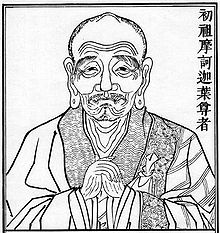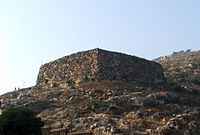- Mahākāśyapa
-
This article is about Mahā Kashyapa, a disciple of Shakyamuni Buddha. For more information on the Hindu sage Kashyapa, see Kashyapa. See also Kassapa Buddha for information on the early Buddha.
Venerable Mahākassapa Other name(s) Mahākāśyapa Religious career Teacher Gautama Buddha Part of a series on
Buddhism
Dharma or concepts
Four Noble Truths
Five Aggregates
Impermanence
Suffering · Non-self
Dependent Origination
Middle Way · Emptiness
Karma · Rebirth
Samsara · CosmologyPractices
Three Jewels
Noble Eightfold Path
Morality · Perfections
Meditation · Mindfulness
Wisdom · Compassion
Aids to Enlightenment
Monasticism · LaityNirvāṇa
Four Stages · Arahant
Buddha · BodhisattvaTraditions · Canons
Theravāda · Pali
Mahāyāna · Chinese
Vajrayāna · TibetanMahākāśyapa (Sanskrit; Pali: Mahākassapa; Japanese: Maha Kasho or Makakasho.) or Kāśyapa was a brahman of Magadha, who became one of the principal disciples of Śākyamuni Buddha and who convened and directed the first council. Mahākāśyapa is one of the most revered of the Buddha's early disciples, foremost in ascetic practices. He is often depicted in statuary together with Ananda, each standing to one side of the Buddha.
Zen purports to lead its adherents to insights akin to that mentioned by Śākyamuni Buddha in his Flower Sermon in which he held up a white flower and just admired it in his hand.[1] Mahākāśyapa smiled faintly, and Śākyamuni Buddha picked that disciple as one who truly understood him and who was worthy to be his successor.[2]
The words of the Śākyamuni Buddha addressed to Mahākāśyapa are described below:[3]
I possess the true Dharma eye, the marvelous mind of Nirvana, the true form of the formless, the subtle dharma gate that does not rest on words or letters but is a special transmission outside of the scriptures. This I entrust to Mahākāśyapa.[3]
Thus, a way within Buddhism developed which concentrated on direct experience rather than on rational creeds or revealed scriptures. Zen is a method of meditative religion which seeks to enlighten people in the manner that the Mahākāśyapa experienced.[2]
In the Song of Enlightenment (證道歌 Zhèngdào gē) of Yǒngjiā Xuánjué (665-713)[4]—one of the chief disciples of Huìnéng, the 6th patriarch of Chan Buddhism—it is written that Bodhidharma was the 28th patriarch in a line of descent from Mahākāśyapa, a disciple of Śākyamuni Buddha, and the first patriarch of Chan Buddhism:
Mahākāśyapa was the first, leading the line of transmission;
- Twenty-eight Fathers followed him in the West;
- The Lamp was then brought over the sea to this country;
- And Bodhidharma became the First Father here:
- His mantle, as we all know, passed over six Fathers,
- And by them many minds came to see the Light.[5]
According to Chinese legend, the monk Ji Gong is a reincarnation of Mahākāśyapa (known as the Taming Dragon arhat). In Lotus Sutra Chapter 6 (Bestowal of Prophecy), the Buddha bestows prophecies of enlightenment on the disciples Mahakashyapa, Subhuti,
Maha Katyayana, and Mahamaudgalyayana.External links
- Mahā Kassapa (subtitle) Father of the Sangha, Hellmuth Hecker, biography based on the Pali Canon, revised and enlarged translation from Wissen und Wandel volume XXI number 6, 1975, (German) by Nyanaponika Thera, The Wheel Publication No. 345, ISBN 955-24-0026-0
- Entry on Maha Kassapa Thera in the Buddhist Dictionary of Pali Proper Names
- "Mahakasyapa's smile" Master Young San Seong Do Snim
Notes
- ^ Some oral lore traditions state it was a rare Udumbara flower of the Lotus Sutra.
- ^ a b Great religions of the world. Center for Distance Learning. Tarrant County College District
- ^ a b Zen Buddhism: A History (India & China) By Heinrich Dumoulin. Translated by James W. Heisig, Paul F. Knitter. Contributor John McRae. Published 2005. World Wisdom, Inc. Religion / World. Religions. 387 pages. ISBN 0941532895. page 9
- ^ Chang, Chung-Yuan (1967). "Ch'an Buddhism: Logical and Illogical".
- ^ Suzuki, Daisetz Teitaro (1948). Manual Of Zen Buddhism, 50.
Buddhist titles Preceded by
Śākyamuni
Beginning of the lineageLineage of Buddhist patriarchs
(According to the Zen schools of China and Japan)Succeeded by
AnandaCategories:- Brahmins
- Disciples of Gautama Buddha
- Arahants
- Zen Patriarchs
Wikimedia Foundation. 2010.



